Picking between Moz, Ahrefs, and Semrush seems like a devilish task to an unskilled eye. All three are famous SEO tools with top-of-the-line features. They count millions of users, as well. However, after examining them for this Semrush vs Moz vs Ahrefs duel, we concluded they are very different.
In short, Semrush and Ahrefs are way better than Moz. In particular, we think Semrush beats Ahrefs and Moz, but don’t think the latter two are bad. They’re excellent, but not every SEO tool will suit your needs. That’s why we’re here — to see which one is best for you.
Ahead of us are multiple comparisons in terms of keyword research, link-building, rank-tracking, content marketing, and much more. We’ll see how all three “behave” and give you our final judgment as to which one is best and why. Let the Ahrefs vs Moz vs Semrush battle begin.
Ahrefs vs Semrush vs Moz: Pricing and Project Limits
Let’s start by comparing their prices, plans, and project limits.
Here’s how much Ahrefs costs at the time of testing:
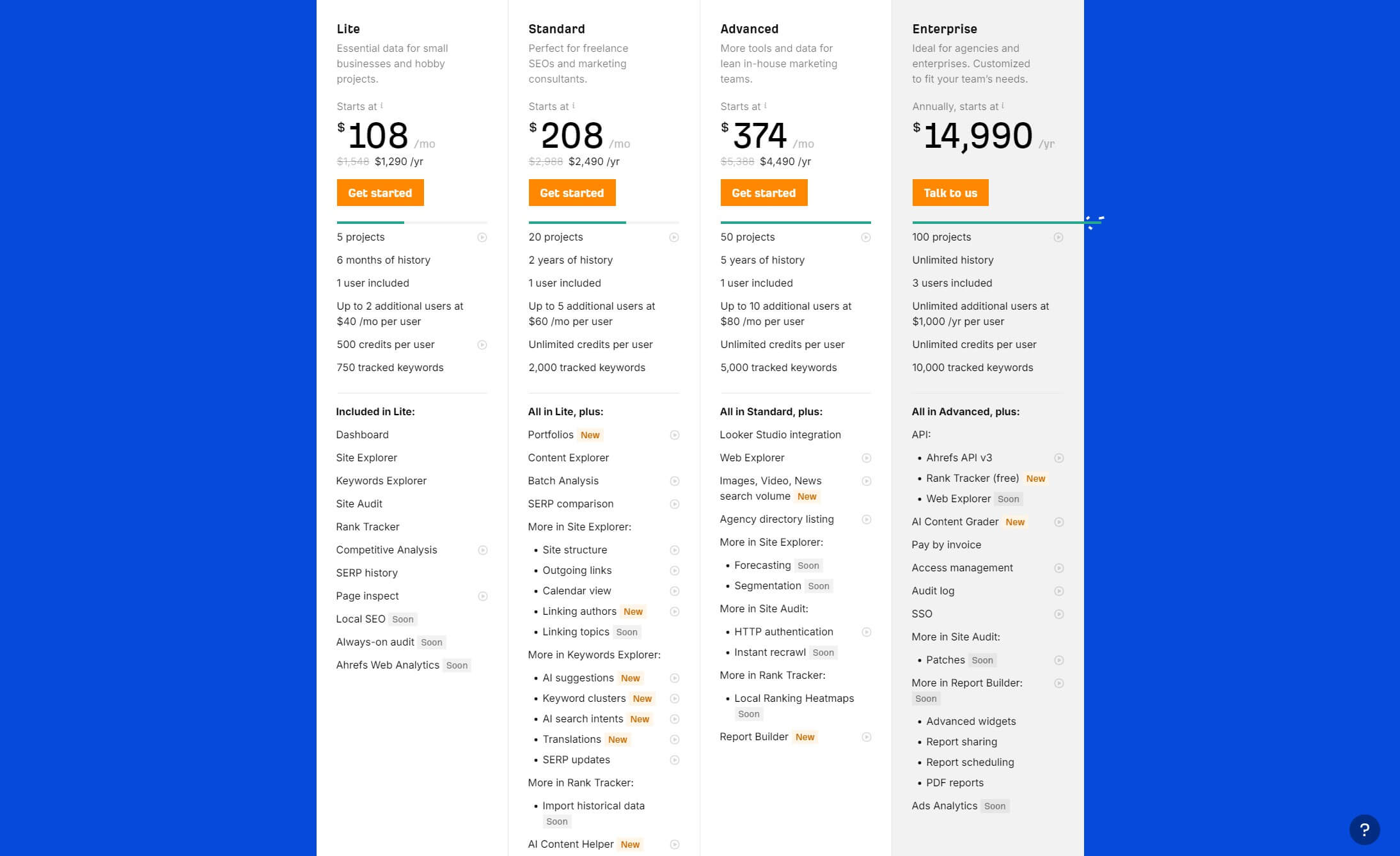
We can see that it starts at $108/mo for the annual plan, which allows you to save 17% compared to the monthly plan. As outlined in our Ahrefs vs Semrush comparison, the latter costs very similarly:
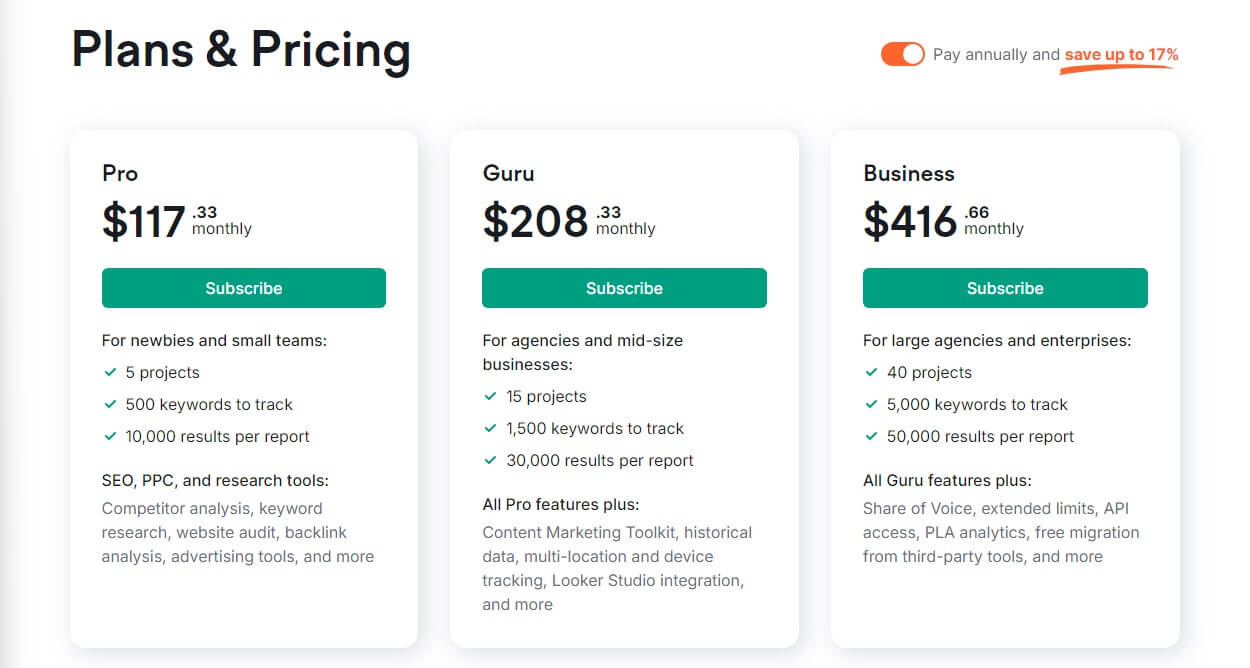
The Pro plan starts at $117.33/mo, but the Guru plan costs virtually the same as the Standard plan from Ahrefs. We’ll compare these two very soon. Finally, here’s Moz, which seems to be the most affordable overall:
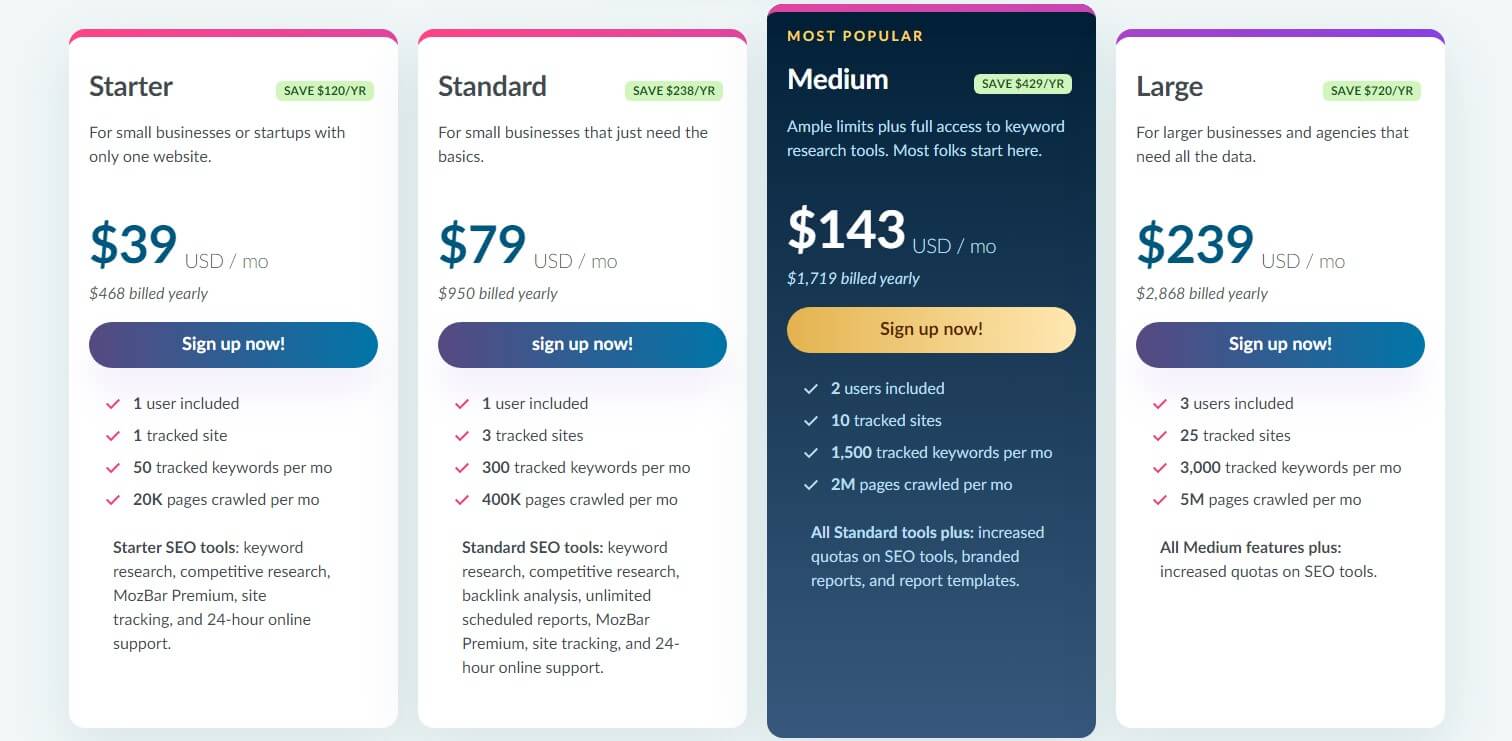
At $39/mo, it’s easily the cheapest of the bunch, but is this all about being the cheapest pick? Not exactly. Being cheap doesn’t always mean bringing great value to the table, which is exactly the case with Moz’s Starter plan. If you choose Moz, you want at least the Medium plan.
This plan, however, costs a whopping $143/mo, which is more than Ahrefs and Semrush’s starting plans.
Project Limits
In this Ahrefs vs Moz vs Semrush review, we noticed how different their project limits are.
We’ve noted them in the table below, which we’ll now examine together.
| Ahrefs | Semrush | Moz | |
| Tracked Keywords | 750 to 5,000 | 500 to 5,000 | 50 to 3,000 |
| Page Crawls per Project | 25,000 to 250,000 | 20,000 to 100,000 | 5,000 to 1,250,000 |
| Default User Seats | 1 ($40-$80/mo/user for additional user seats) | 1 ($45-$100/mo/user for additional user seat) | 1 to 3 |
| Rank Tracking Updates | Weekly | Daily | Daily |
| Number of Projects | 5 to 50 | 5 to 40 | 1 to 25 |
To determine which SEO tool offers the best value, we need to look at the project limits. They’re, as expected, way different. Ahrefs offers more in its cheapest plan than Semrush, but simultaneously provides only weekly rank-tracking updates and charges you $100/mo for daily updates.
Both of them, however, can track more keywords than Moz, which caps at 3,000. Some of Moz’s plans, including Medium, allow for more than one user seat. By default, Ahrefs and Semrush are only for a single user, who must pay at least $40/mo for one more user seat.
Interestingly, Moz allows for 25 websites in its most expensive plan, whilst Semrush and Ahrefs cap at 40 and 50, respectively. Bear in mind that Ahrefs uses the credit system, which is used pretty much for every action, so if you have 500 credits in the Lite plan, you can perform that many “actions”.
This means the initial plan can and will cost more than $108/mo, making the Standard plan with unlimited credits the best option. At this price, you can get Semrush as an Ahrefs alternative and enjoy even more features. Moz is in an interesting position here.
Its Medium plan costs less but provides less. Its Large plan is $239/mo, costing more than the Guru and Standard plans in Semrush and Ahrefs, respectively, while also providing slightly less. Thus, Moz instantly loses the battle against the two giants.
Note that all three offer excellent free SEO tools, but they are, of course, very limited.
Which SEO Tool Wins?
The conclusion is fairly simple. If you’re after the cheapest possible SEO tool out of these three, Moz will fit the bill perfectly, and immediately after, there are Ahrefs and Semrush with minor price differences.
But if you’re seeking the best value for money, the situation is clearer than ever:
- Semrush offers the most features for the price — we recommend the Guru plan.
- Ahrefs is very close to Semrush value-wise, but only in its Standard plan.
- Moz costs less but offers fewer features and lower project limits.
Save 17% on Semrush Annual Plans
Which One Is Best for Keyword Research?
With the first round out of the way, let’s see how Semrush, Ahrefs, and Moz perform in keyword research. After testing all three and comparing them directly, we always returned to Semrush for the reasons explained below.
Keyword Research With Ahrefs
Ahrefs performs like a charm for keyword research, being one of the best tools for this purpose.
The Keyword Explorer tool tells you everything you should know about a keyword. Provide one, and you’ll see metrics like difficulty, volume, traffic potential, ideas, questions, search suggestions, traffic share, and more. The cheapest plan lacks one thing: search intent.
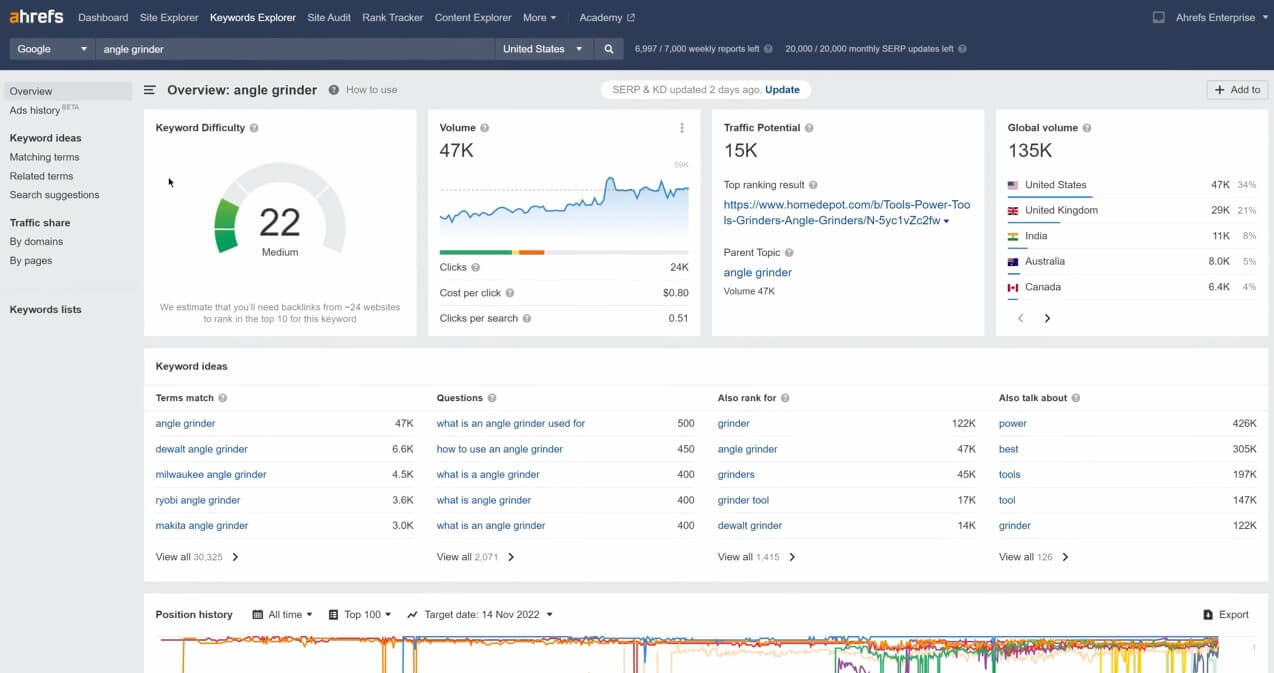
We’re fond of this metric because it explains why people search for the keyword. It can be helpful in keyword research because using more “commercial” keywords, for example, leads to more sales. If you’re writing a blog, you want more “informational” keywords, etc.
The balancing “act” is Ahrefs’ Organic Keyword Tool, which discovers your competitors’ ranking keywords. You can find long-tail keywords here that can be used in your SEO campaign. Finally, we’ll mention the Content Gap tool, which is befitting for this category.

You can use it to detect your competitors’ ranking keywords that you don’t have. Better yet, you can filter the results so that you can see the keywords that at least one, or all of your competitors rank for. Pretty clever.
Keyword Research With Moz
Moz comes up with some basic but useful keyword metrics. After analyzing multiple keywords, we found pretty much the same information from Ahrefs, but this time, the search intent was there. I mean, this is a must in every SEO tool, and Moz introduced it recently.
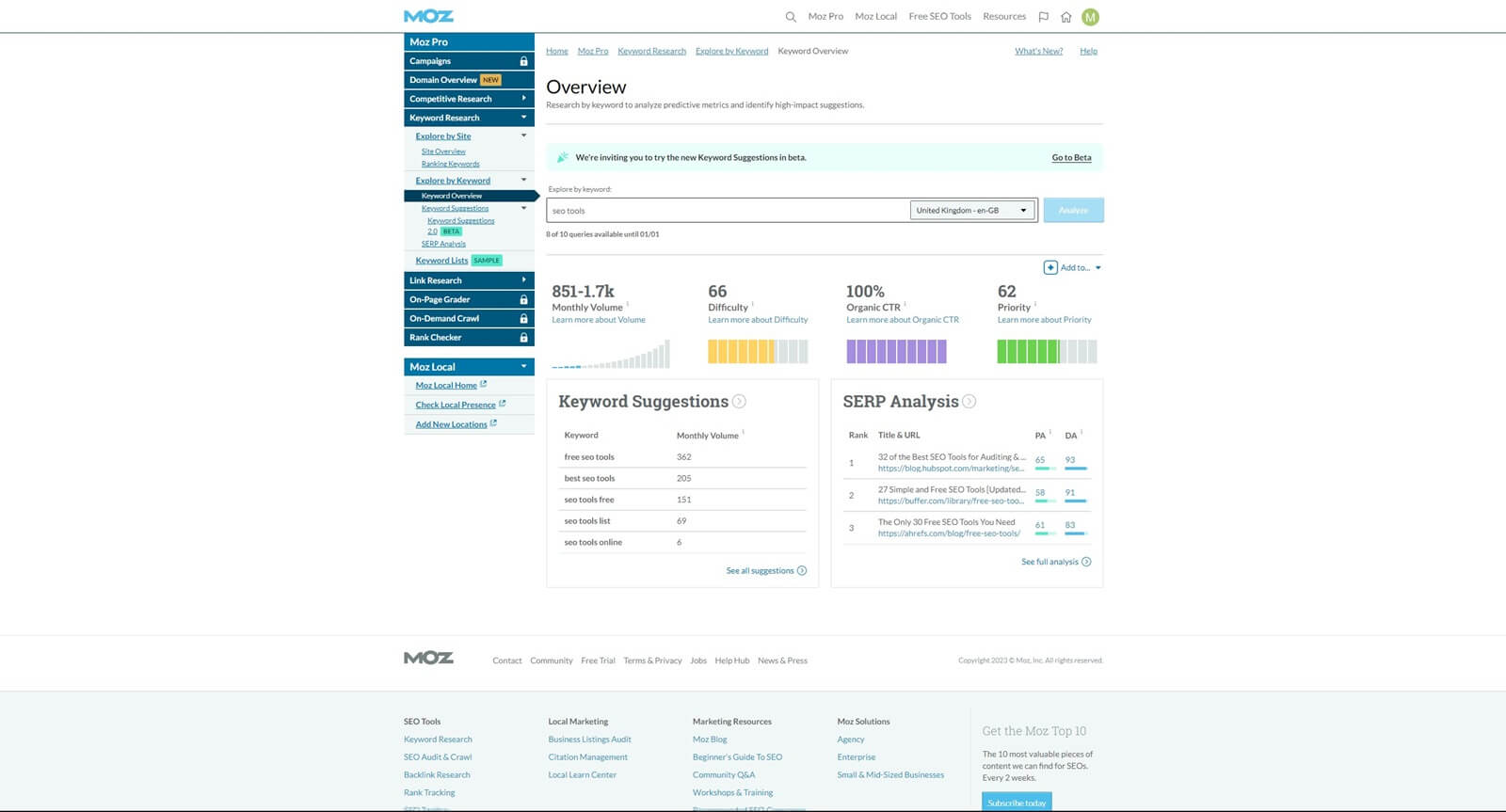
The bad news is that Moz’s keyword base isn’t the largest. For example, when we analyzed the same domain in all three tools, Moz found the least ranking keywords. This is compensated by Moz AI, which complements keyword research with more handy information.
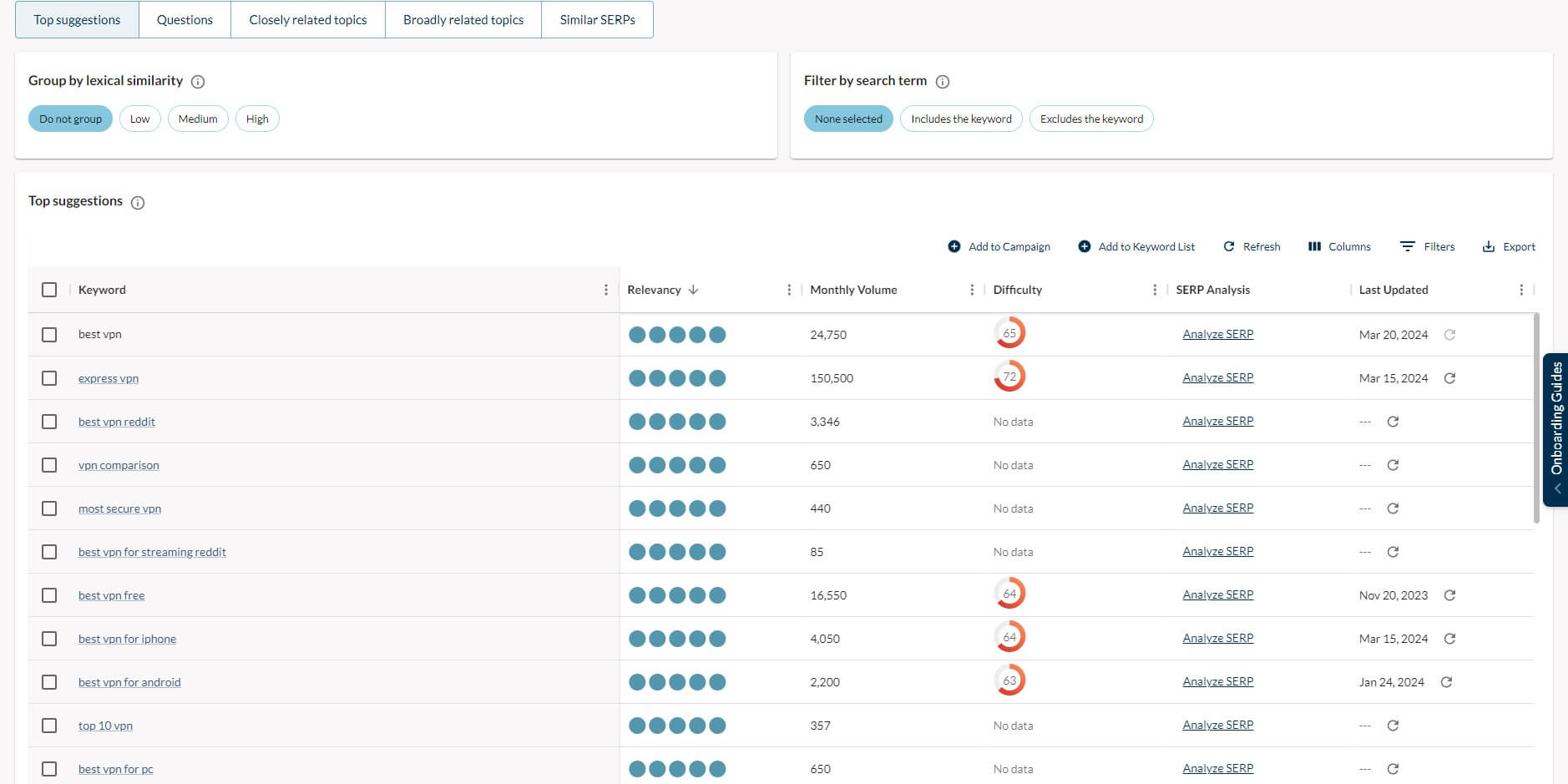
Such information also includes keyword suggestions and questions. We then have the Keyword Gap tool, which does the same thing as before. It’s great for detecting which keywords your competitors rank for that you don’t, so that you can leverage that.
Keyword Research With Semrush
We now get to Semrush, which performs the best in this aspect. Its Keyword Overview tool is the most comprehensive and information-filled. There’s everything from before, plus information about CPC, competitive density, search intent, trend, SERP analysis, etc.
In a recent SpyFu vs Semrush analysis, we confirmed that the latter is even better than SpyFu for PPC campaigns and advertising. This is also due to its substantial keyword database, which shines within the Keyword Magic Tool. This is where the real magic happens!

Once you provide the seed keyword, Semrush swarms you with hundreds of suggestions and questions. You have advanced filters to find specific search intents, long-tail keywords, phrase matches, and more.
The Keyword Strategy Builder is another banger, with a comprehensive topical overview, which displays hundreds of topics based on the provided keyword. Not only that, you also get ideas for pillar pages with their advised structures and titles, most of which make sense!
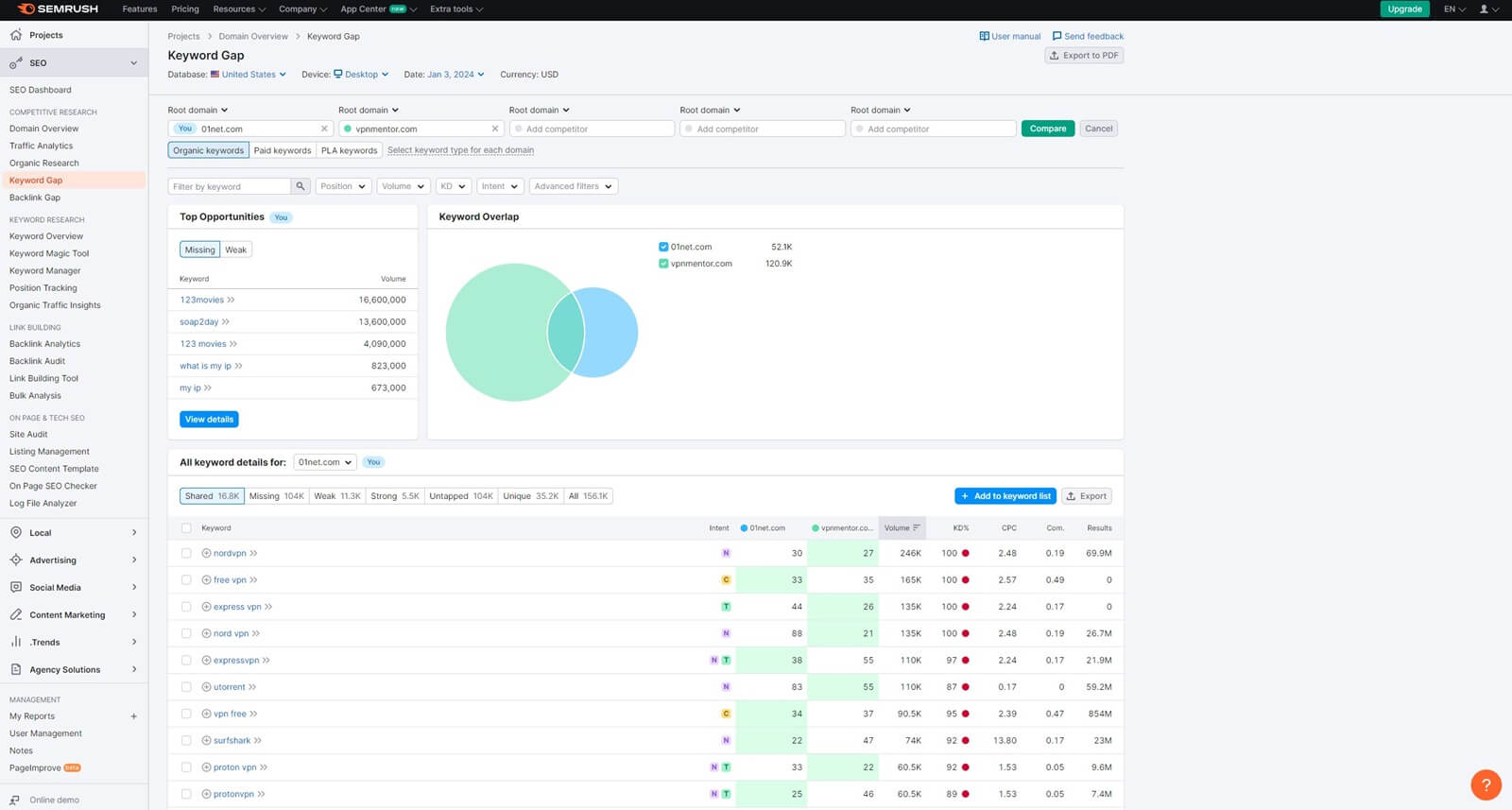
Like the rest of the “pack,” Semrush has a Keyword Gap tool, but with even more detailed filters to dig out the most “stubborn” information about your competitors.
Being more advanced and with more keyword research features than both, Semrush wins the second round, with Ahrefs slightly behind, and Moz being the least impressive SEO tool in this trio.
Rank Tracking
We discussed project limits in this Ahrefs vs Moz vs Semrush comparison, mentioning that Ahrefs updates information weekly. This makes it inferior to the other two, right? In short, no. We were surprised that it performs closely to Semrush, while Moz was, again, the least impressive.
Rank Tracker Tool in Ahrefs
Ahrefs has a Rank Tracker tool, which works incredibly well. From visibility, average position, and traffic to SERP features, trends, and everything else — Ahrefs has it all! There’s a unique Share of Voice metric, plus, you can see the number of organic clicks that led to your site.
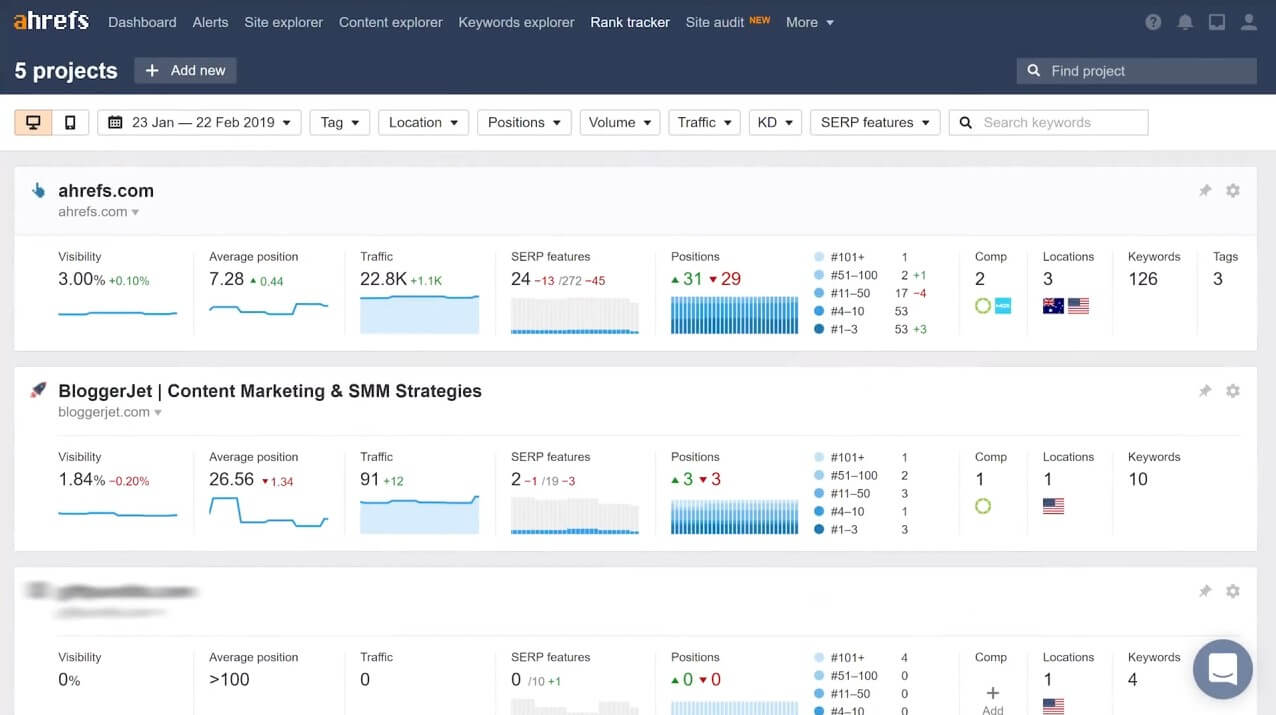
Ahrefs lets you integrate Google Search Console, which provides accurate information about your current rankings. For added convenience, Ahrefs included the Competitors section, where you can measure your ranking performance against your competitors easily.
Unlike Semrush, which we’ll analyze now, Ahrefs lacks daily updates in the cheapest plan, and there are no cannibalization reports. Overall, however, Ahrefs provides ample information you’ll find useful.
Position Tracking in Semrush
Semrush is just a bit better, and it’s no wonder it’s our favorite SEO tool.
With things like visibility, traffic estimations, and average positions, Semrush tracks every aspect of your keyword. In the Guru plan, you get cannibalization reports, which display if two or more pages rank for the same keyword and harm each other’s rankings.
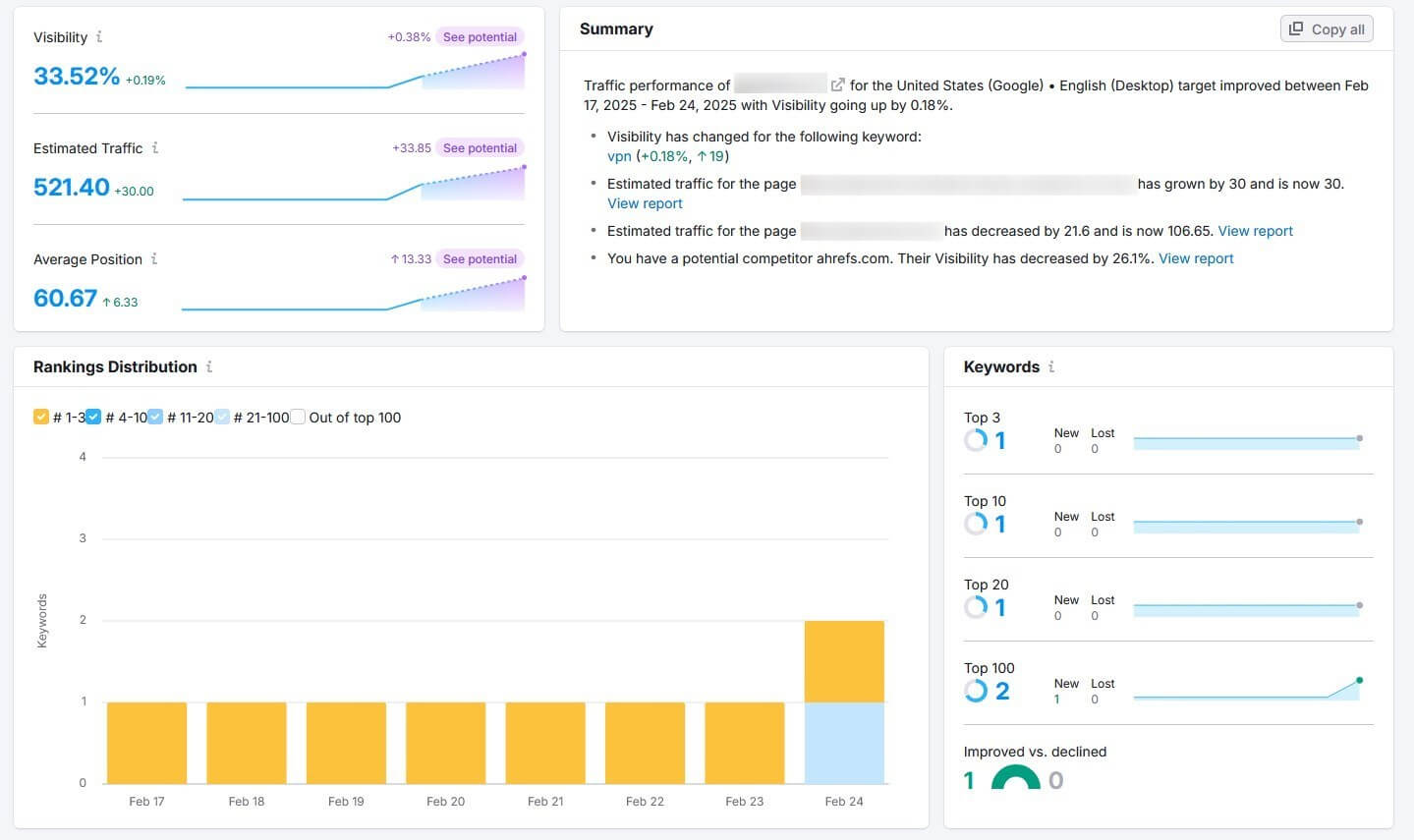
However, there’s multi-device, multi-location tracking, which gives you a broader overview of your keyword’s performance. This is exceptional when you’re tackling multiple markets, in which case, you should have enough to splurge on the powerful Guru plan.
Let’s not forget that each plan comes with daily updates and up to 5,000 tracked keywords.
Rank Checker in Moz
Moz’s Rank Checker updates information daily but offers the least “meat” compared to its rivals. It’s very easy to set up and use, but the information you get is limited to the volume, difficulty, visibility, and ranking.
You can also choose from a few different search engines: Google, Bing, and Yahoo.
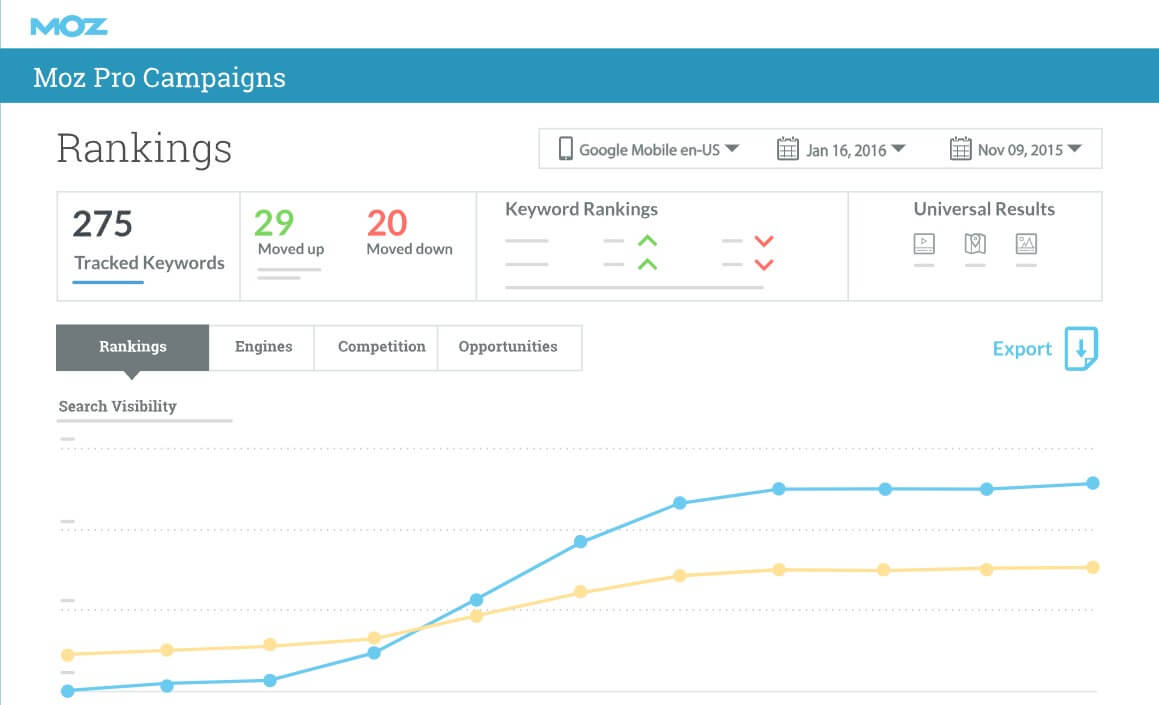
We noticed that Moz offers way less information than Ahrefs and Semrush. Yet, it also lacks cannibalization reports and multi-location/multi-device tracking in Semrush. It works, but so does an old beater car — it goes well only to the local store, half a mile away from your place.
With everything said, Semrush is the best option for rank-tracking because of cannibalization reports, multi-device/location tracking, and daily updates in all plans. Ahrefs follows closely with a litany of information, and Moz lags with its bare-bones Rank Checker tool.
Backlink Research Comparison
After keyword-related comparisons, let’s see how the trio stacks up for backlink research.
Ahrefs
Whenever we need this type of research, we usually go for Ahrefs or Semrush.
They’re very good, and the Site Explorer tool from Ahrefs works tremendously. You’ll need to provide the website address, and after a second or two, Ahrefs will spill out the beans. Number of referring domains, domain ranking, traffic, paid keywords, authority score, etc.
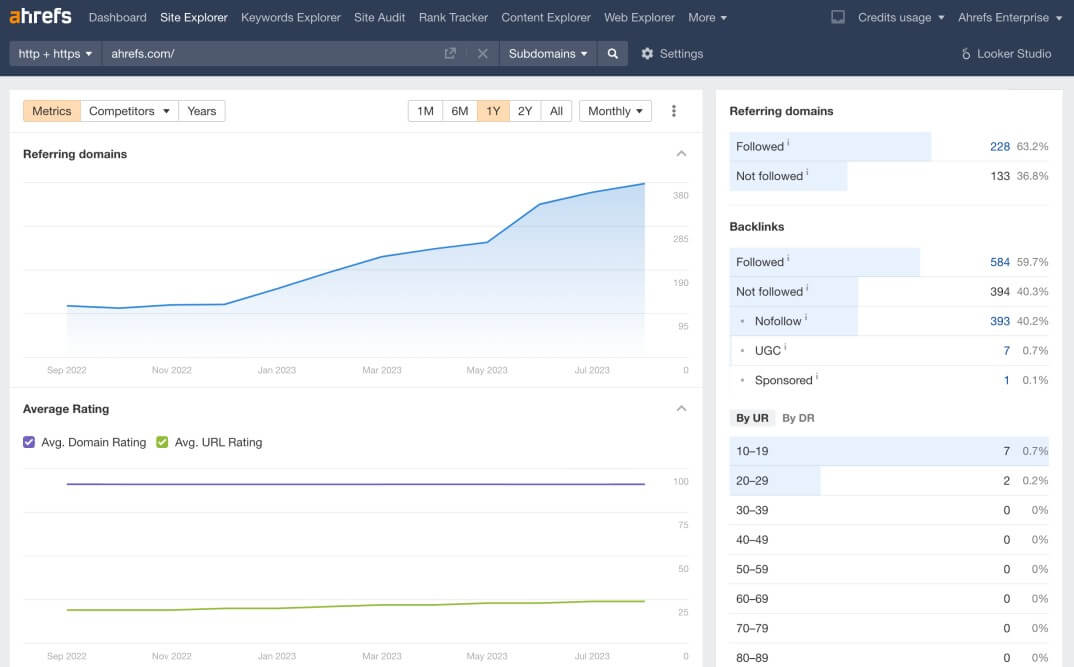
In the tool, you’ll also find the Broken Backlinks menu, where you can discover broken backlinks, fix them, and prevent further harm. The Site Explorer tool contains some interesting options, such as organic and paid search, which house more information.
For example, you can see the most used anchors for linking and find out your competitor’s linking patterns. The Link Intersect tool is here as well, and it’s a standard backlink gap tool. It discovers linking domains from your competitor that you don’t have. Great stuff.
Semrush
Semrush’s Backlink Analytics works equally well or perhaps a bit better. You’ll get the same subset of information, with stuff like graphically displayed authority score, network graph, and toxicity score on top.
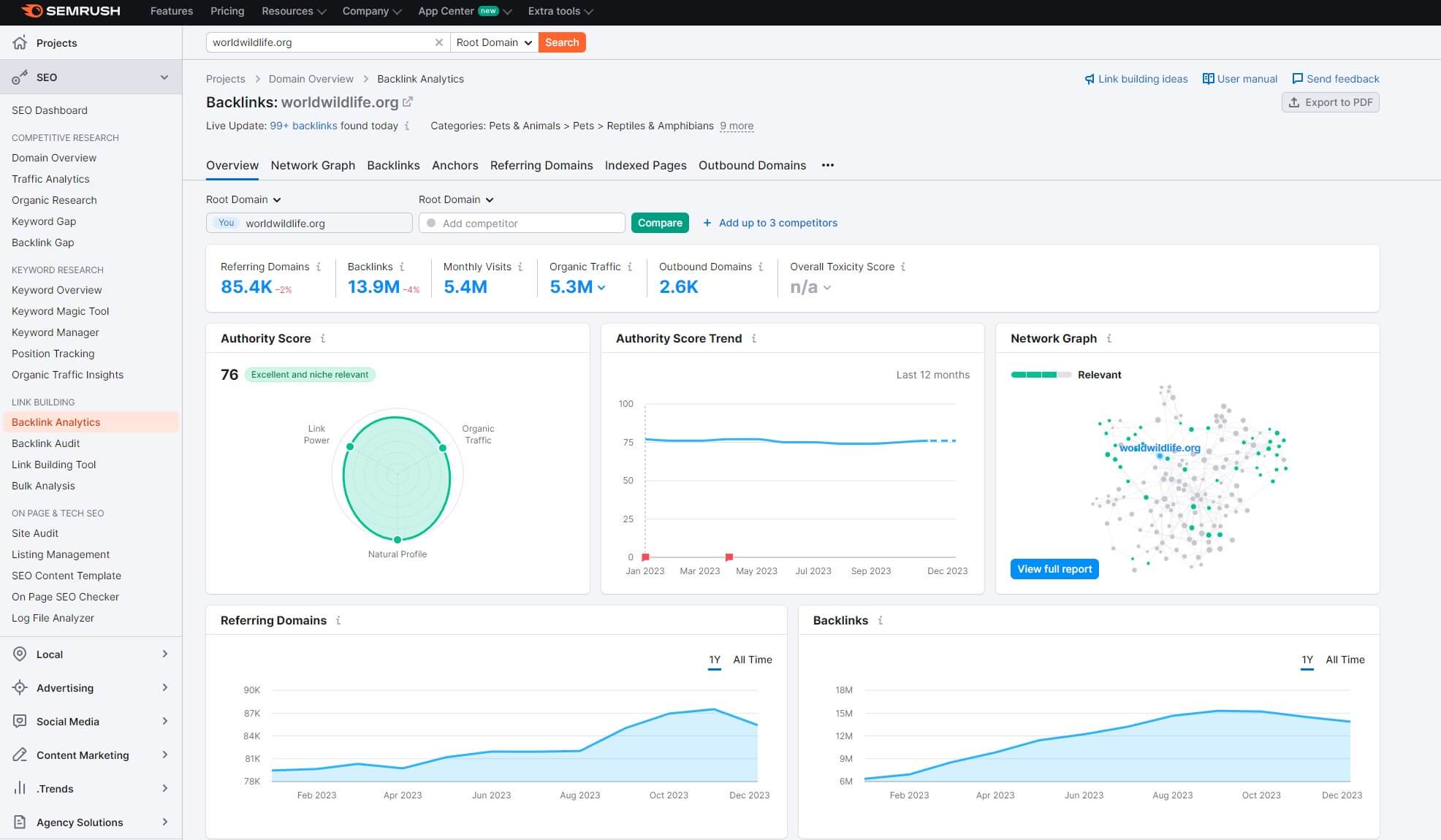
If you click on the toxicity score, you’ll find toxic backlinks that you can remove to ensure your website ranks properly. Like Ahrefs, Semrush allows you to find broken backlinks, but you can also find new and lost backlinks for more information. This is done with the Backlink Audit tool.
Beware that Ahrefs lacks this one!
The Backlink Audit tool also has the Disavow function, which tells Google to ignore the specific link, for example, a toxic link. Last but not least, you’ll find the Backlink Gap tool, allowing you to see which domains link to your competitors but not yours, so that you can close that gap.
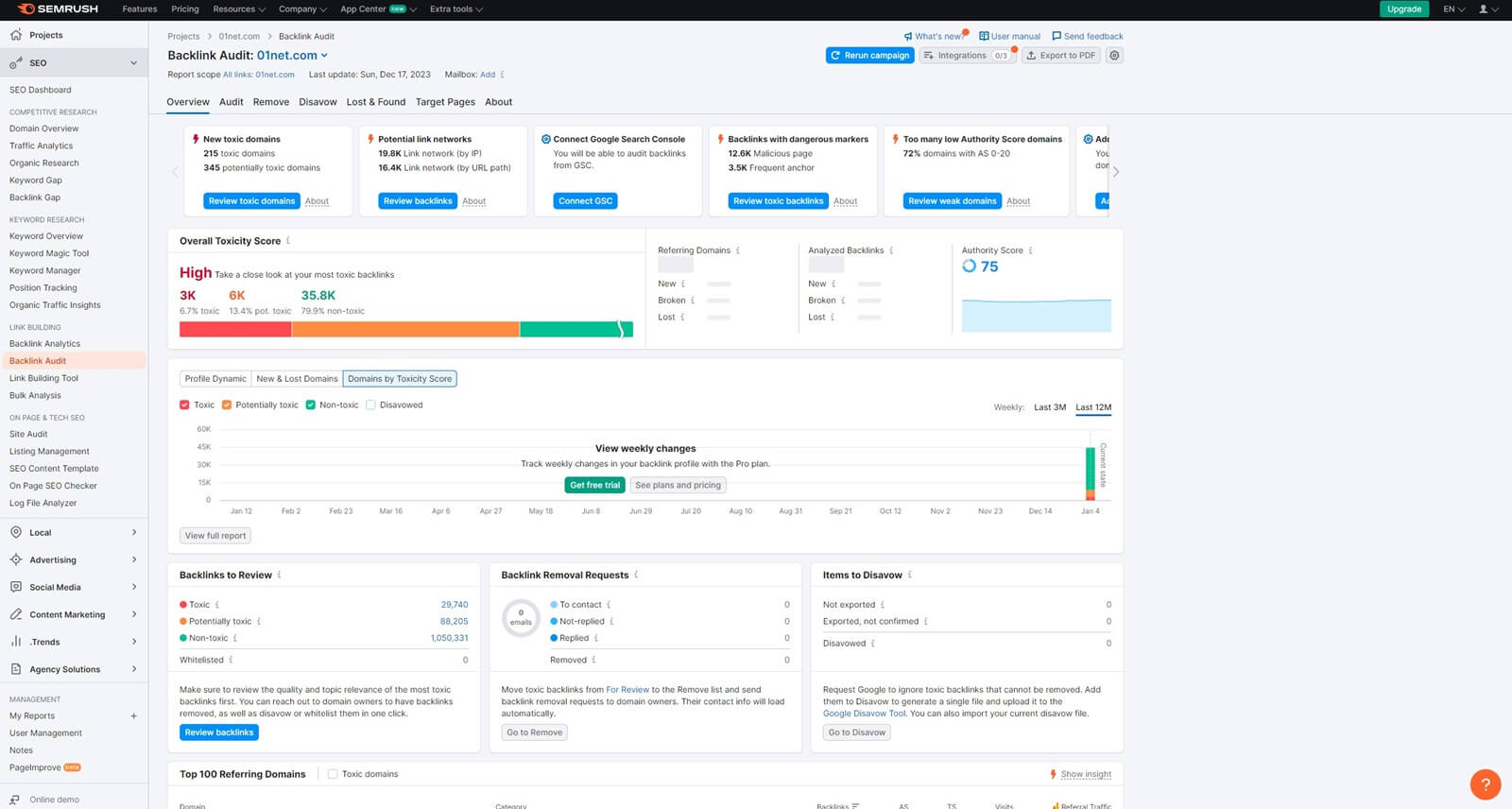
You can find out more about this feature in our full Semrush review for 2025.
Moz
Moz comes with the Link Research tool, which works well for the most part. However, due to Moz’s smaller backlink database, it constantly detects fewer referring domains than Semrush and Ahrefs. To be honest, Ahrefs sometimes detects MORE referring domains than Semrush!
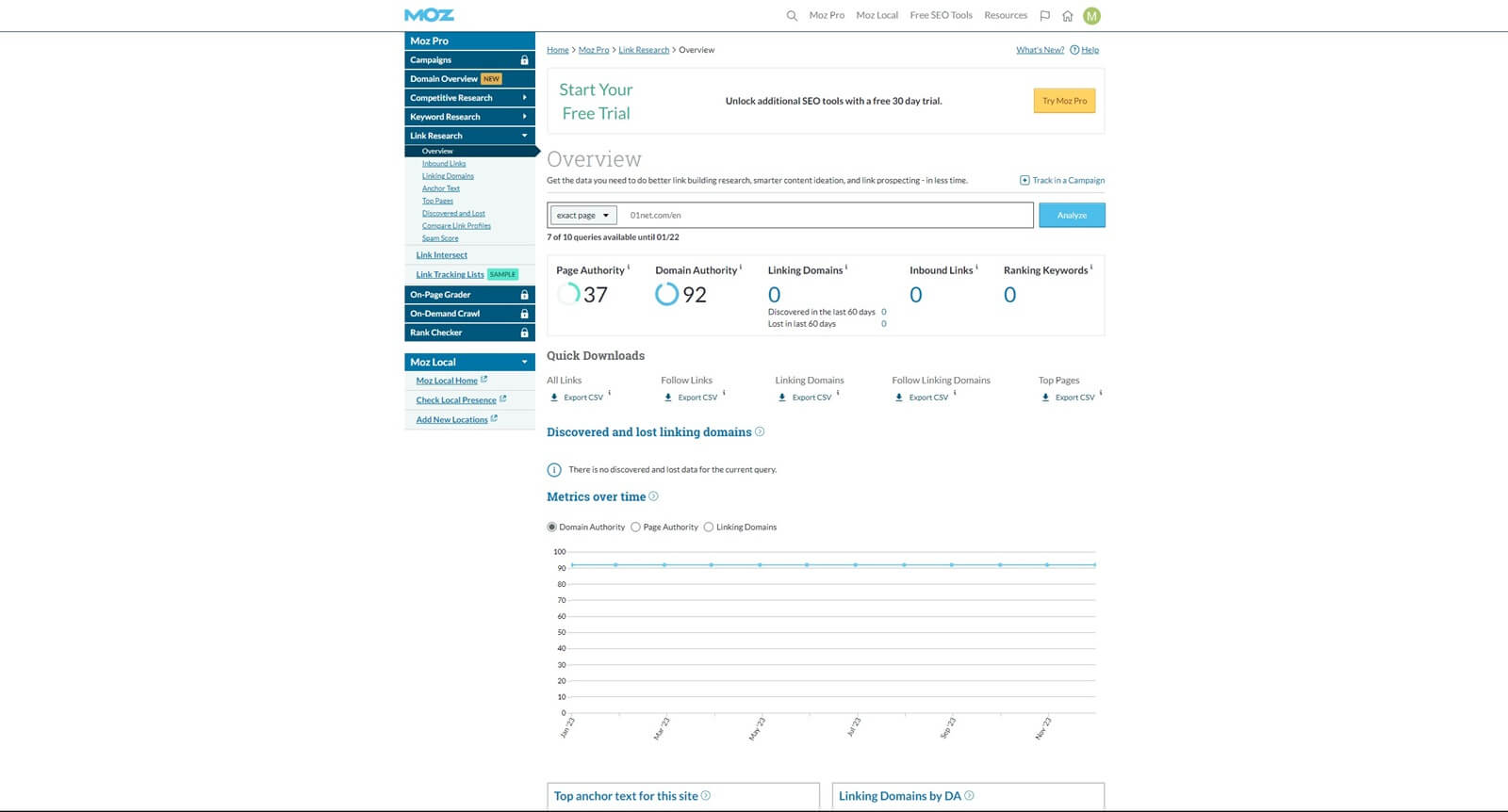
Either way, the Link Research tool is good, but nothing more than that as stated in the full review of Moz Pro.
You’ll see domain authority, linking domains, inbound links, and discovered/lost linking domains. Top pages and the most used anchor texts are also here, so Moz provides plenty of valuable information.
We love that it displays the percentage of follow and nofollow links, with a handy Spam Score bit of data that gauges your backlink toxicity. Backlink gaps can be detected with the Link Intersect tool (it’s called the same in Ahrefs), where you can compare your domain to five more.
During our Semrush vs Ahrefs vs Moz assessment, we found that Semrush and Ahrefs perform better for backlink research. We’d give Semrush an advantage because of the backlink audit tool, then Ahrefs because of its precise information, and then Moz as a more “average” performer.
Link-Building: Semrush vs Ahrefs vs Moz
Link-building is generally a multi-disciplinary process that involves multiple factors. However, some SEO tools, like Semrush, have dedicated link-building tools. Semrush’s one is extremely well-done and is a CRM with the prospects that represent the recommended backlink opportunities.
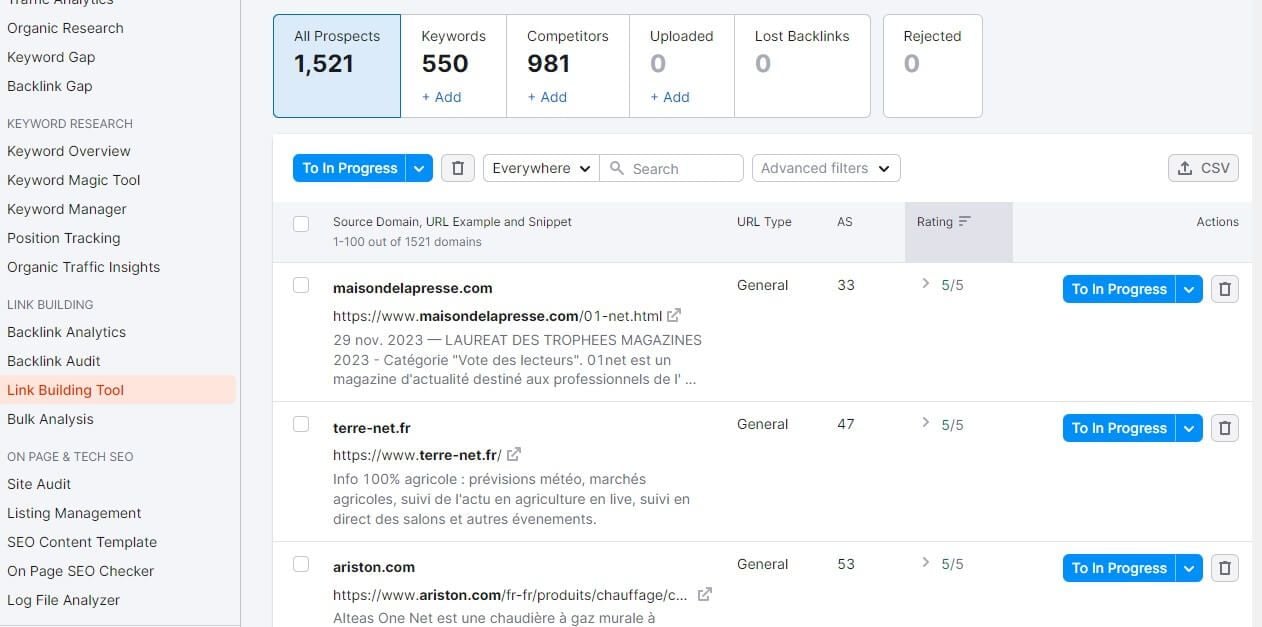
Semrush will list them neatly and then allow you to contact each “prospect” (website) to request a backlink. Users can also request guest posts and collaborate with other websites to provide support to each other.
We haven’t found anything similar in Ahrefs and Moz, so neither is as impressive.
Ahrefs has something close to that — Content Explorer.
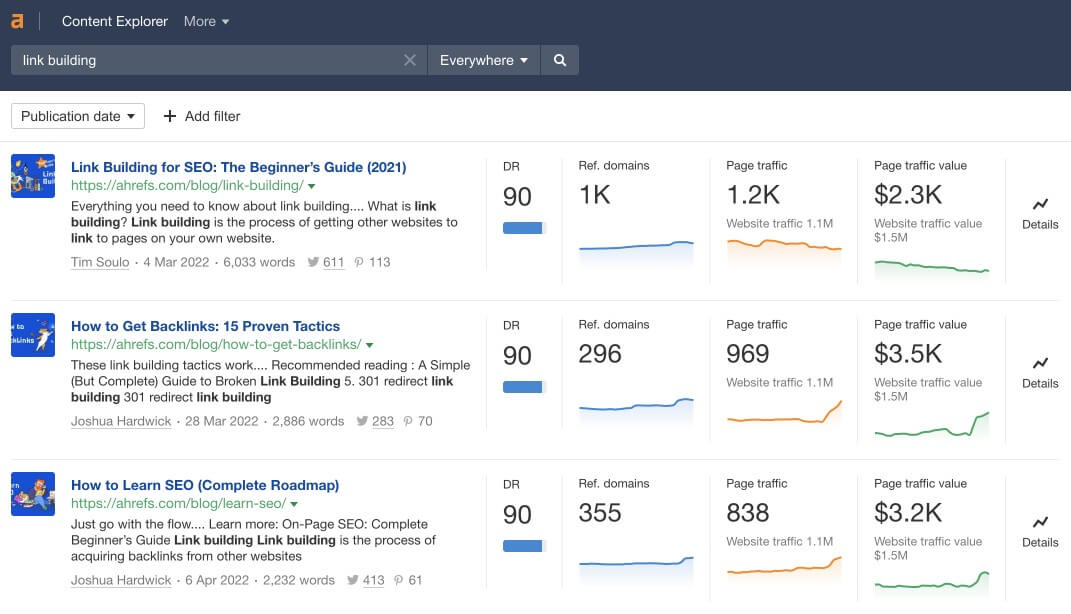
However, it only detects the top-performing content and displays link prospects — there’s no outreach function from Semrush. Moz doesn’t even offer that. It lacks any form of dedicated link-building tool, making it the least impressive option in this comparison.
Refer to this guide for the best link-building tools if you need some of them.
So, as Semrush has a dedicated tool for link-building, it takes this round. The Content Explorer in Ahrefs is also a handy tool for link prospects, while Moz falls behind, with no formidable “answer” to its opponents’ features.
Website Auditing: Which SEO Tool is Best?
At the start of our Moz vs Semrush vs Ahrefs comparison, we figured out that Ahrefs has some of the most generous crawling limits. Its cheapest plan crawls 25K pages per project, while Moz crawls only 5K, albeit at a way lower price. Semrush crawls 20K, which is solid.
That, if you have a larger website, Ahrefs will be the best in terms of the number of pages it can audit. But which one is best for site audits overall? We think Semrush and Ahrefs are almost on par, while again, Moz falls behind slightly.
Semrush
Semrush covers two aspects of your website — site audits and on-page SEO.
The first one detects issues that need solving, plus, there’s the Core Web Vitals part, where you can see your website’s performance. Semrush will find healthy and broken pages, as well as discover issues with your “robots.txt” file, which is pretty handy.
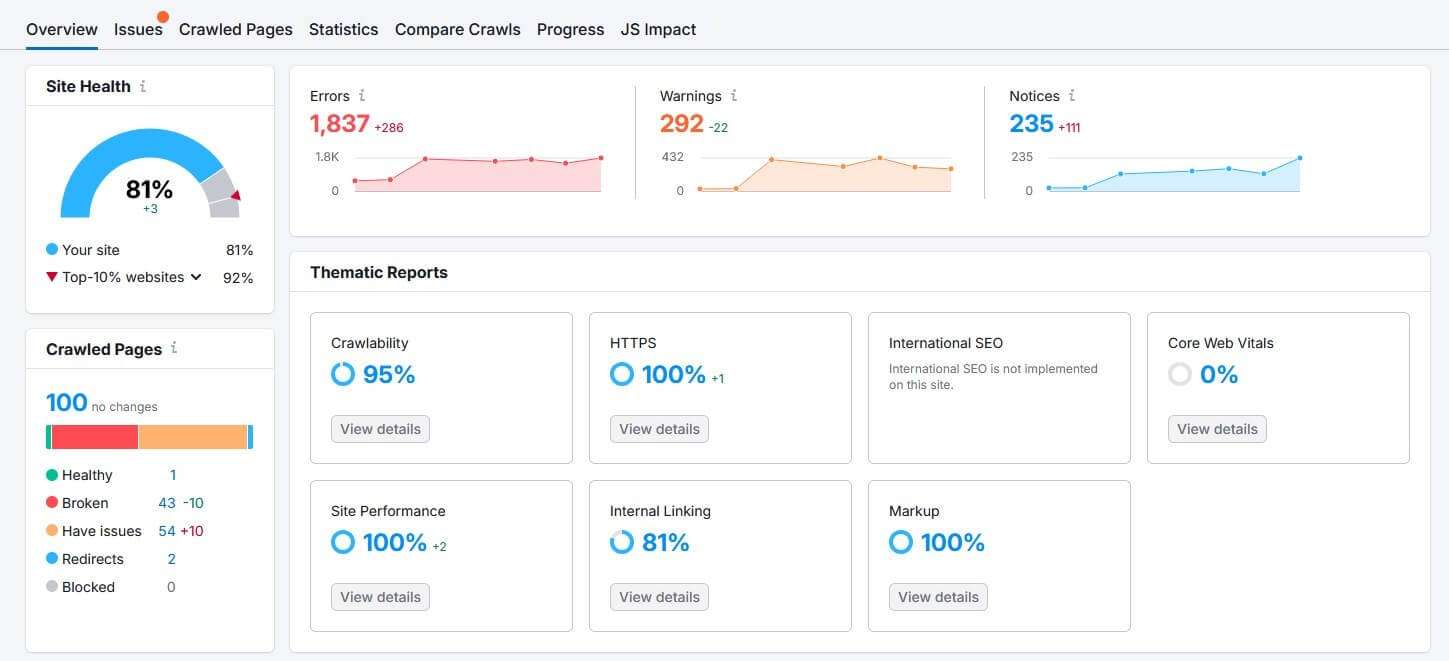
Its clever interface also highlights the top issues that need fixing and paints them in red to make them more easily visible. You can compare crawls to see if there’s any progress from the last crawl. Semrush enables an audit of a single page, which is one of its best tools.
The On-Page SEO Checker gives you an overview of the page, with optimization ideas and tasks that you need to complete. It also lists the top pages to optimize with, again optimization ideas to guide you in the right direction. Semrush really delivers on this front.
Ahrefs
Ahrefs was never the best option for site audits, but 2025 sings another song. Today, its Site Audit tool is a great detector of website audits that are promptly displayed on the home screen. You’ll find duplicates, performance issues, meta description problems, and more.
One thing that lacks is the Core Web Vitals, but you can refer to Google Search Console for that.
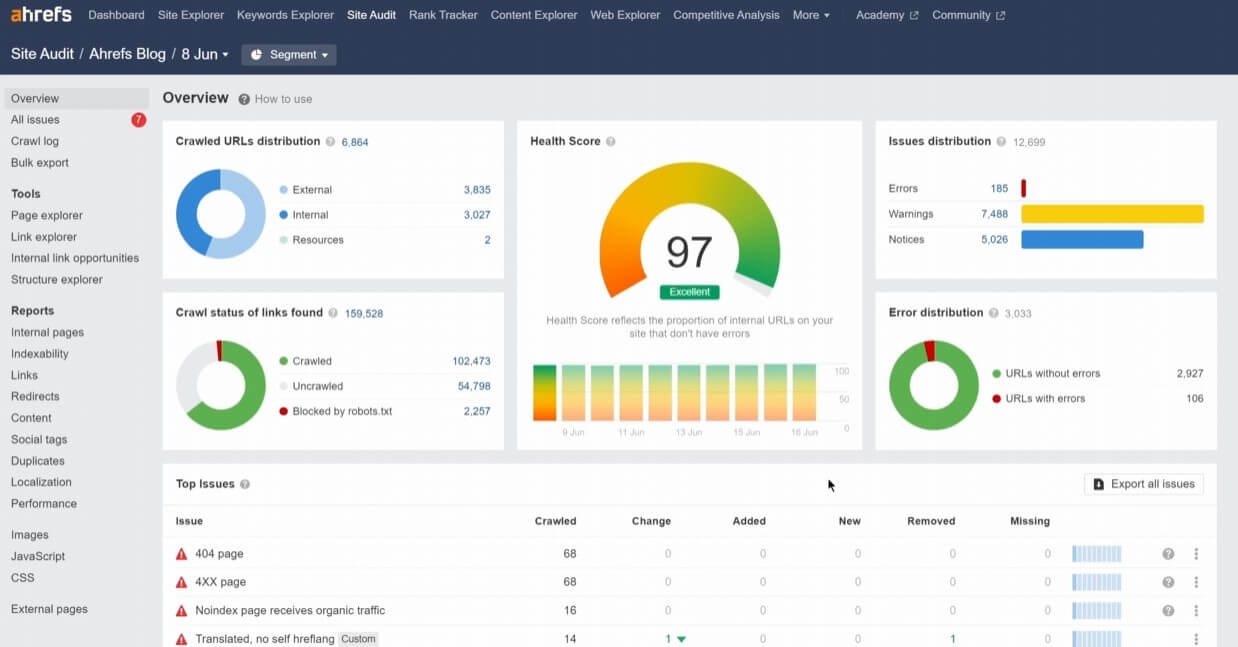
We must mention that Ahrefs crawls pages very quickly, and apart from simply displaying the issues, it advises you on how to fix them. One metric we found handy is the distance of other pages to your home page, which can be found in the Structure Explorer tool.
The more distant the other pages are, the worse your UX is. That said, you can use Ahrefs’ Site Audit tool to improve the user experience and ensure a better Google ranking.
Moz
Moz Pro is great for website audits thanks to its On-Demand Crawl tool. Don’t be fooled into thinking it’s advanced — it’s not. Moz will crawl your pages efficiently and spill out the graph with the most pressing issues. You’ll also see your Core Web Vitals — that’s something!
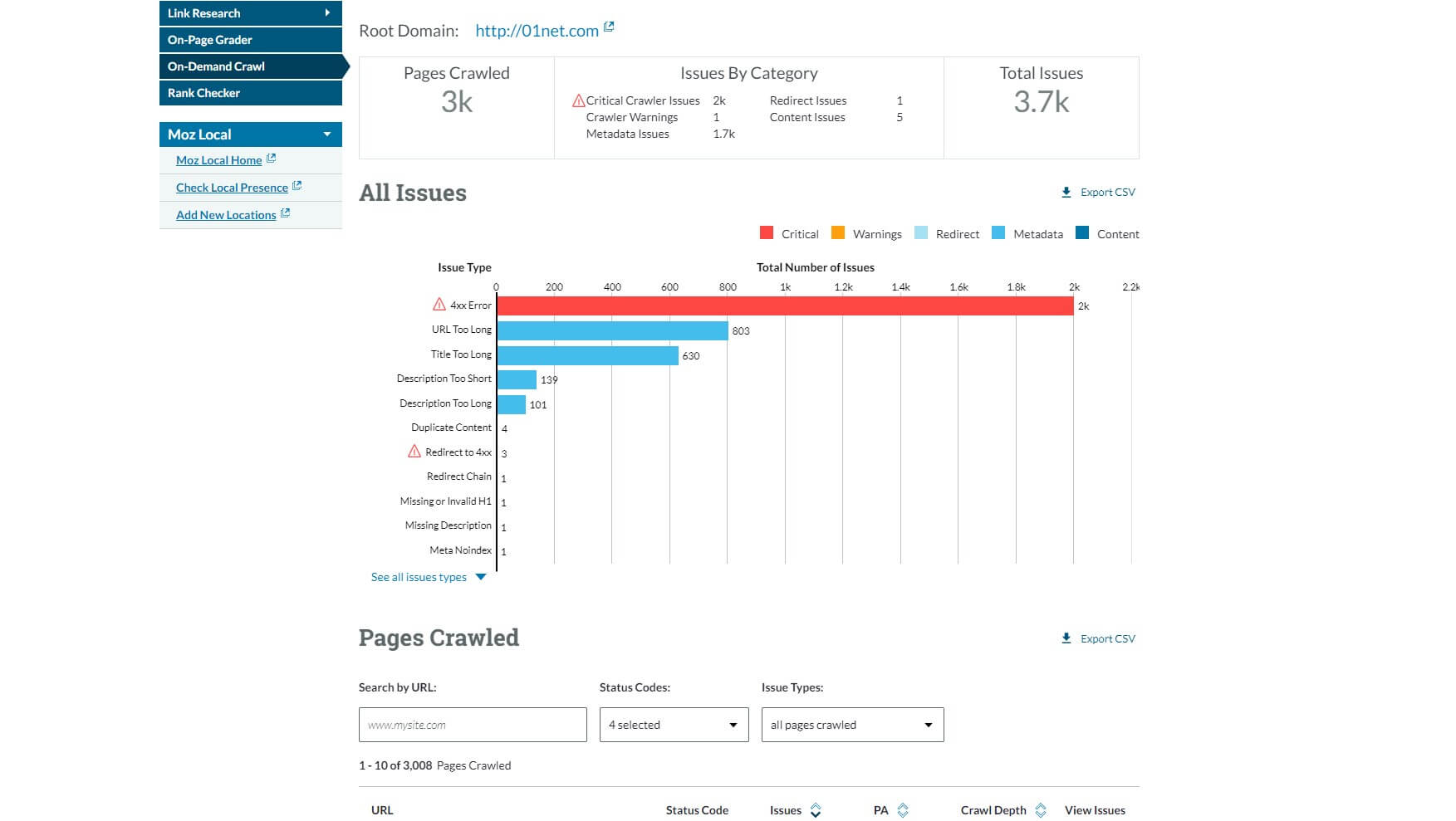
Apart from that, there’s the On-Page Grader tool, which mimics (badly) Semrush’s On-Page SEO Checker. The tool provides you with the page score based on its SEO, without optimization ideas, making it feel half-baked instead of fully done.
After our comprehensive tests, we found that Semrush is the best option for complete site auditing. With Ahrefs being slightly behind. Moz was the biggest disappointment, as its elementary website audits likely won’t bode well for more advanced users who expect more.
Content Marketing, Research, and Optimization
Let’s immediately remove one SEO tool from this equation — Moz Pro.
It doesn’t offer any value for content marketing, which is why it was inferior to Semrush in our comparison. Ahrefs used to be the same long ago, but recent improvements have brought some new features to the repertoire. Ahrefs now offers two amazing tools:
- Content Explorer
- AI Content Helper
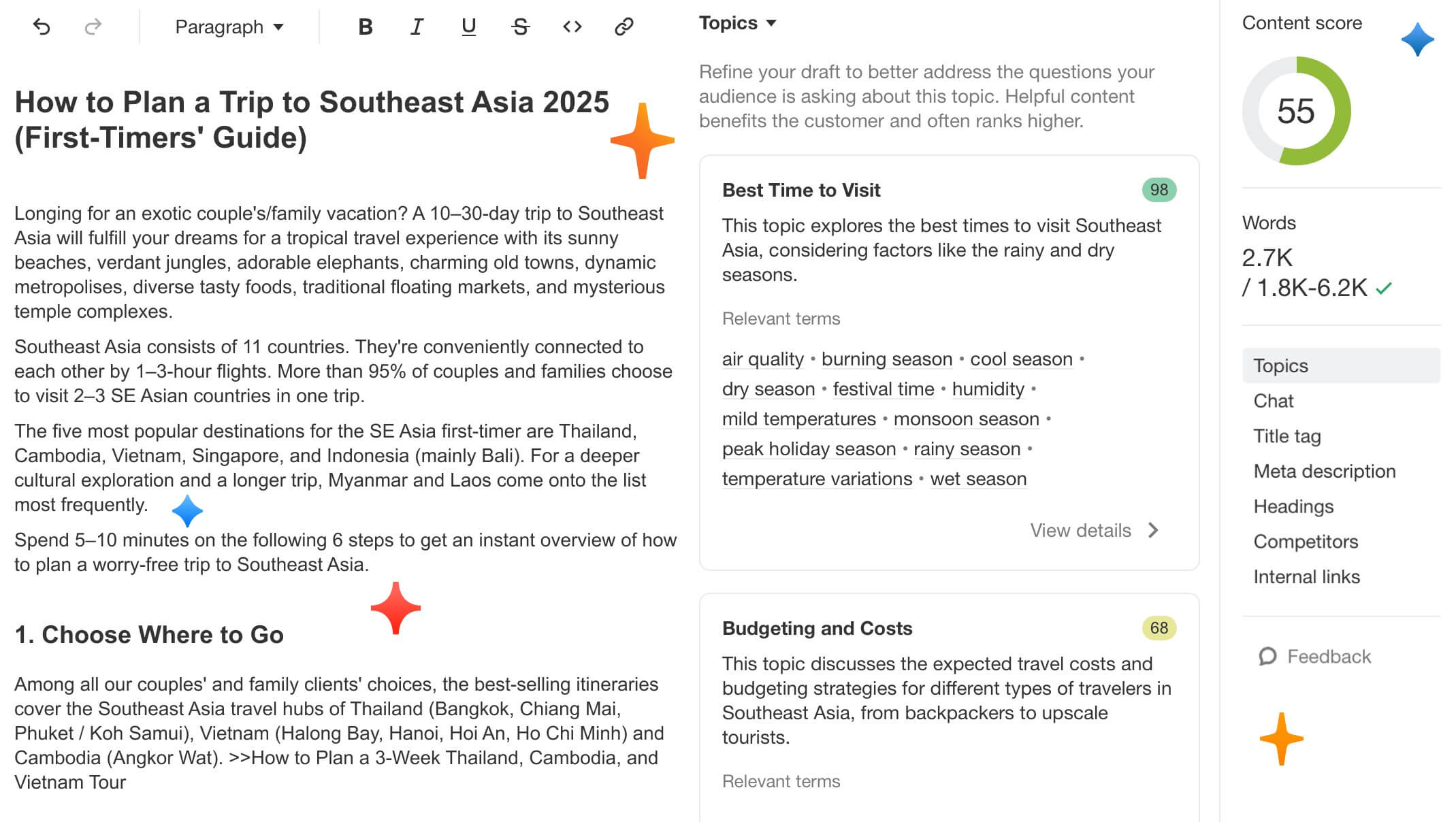
We discussed Content Explorer earlier. It’s a solid option for content ideas and link prospects, but its AI Content Helper is from another planet! It allows you to write and optimize content in 174+ languages, ensuring several key factors in the process:
- Better topical coverage
- Adequate keyword intent
- Proper SEO
- Optimized meta descriptions/titles
We tested it many times and were impressed with its outstanding performance. It makes content optimization foolproof and simple. Just beware that it’s not available in the Lite plan — you have to spend at least $208/mo for the Standard plan for AI suggestions.
What About Semrush?
Semrush also reserves content marketing for the Guru plan, which, to remind you, costs the same as the Standard plan in Ahrefs. At this price, you’re getting a bit more in this regard.
Semrush comes with the Topic Research tool, which provides a swarm of topics based on the SEO keywords. Each content idea comes with its keywords and ideas for headlines, plus questions that you need to address. Most of the time, its content ideas make sense.
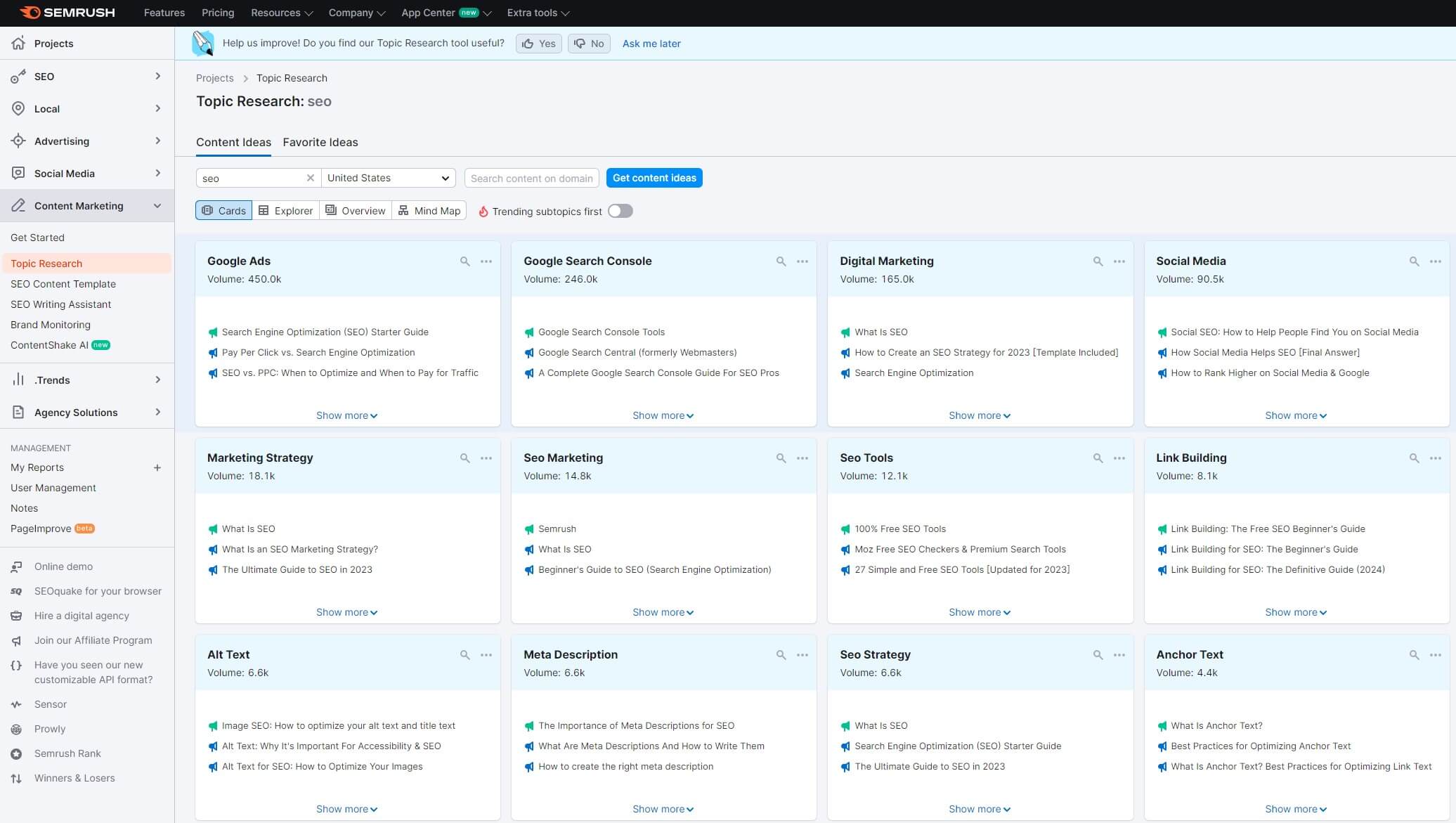
In very few instances, we found too broad or unrelated topics that we discarded.
Our favorite is the SEO Writing Assistant, which helps you write better content with helpful suggestions. It can also write content for you, thanks to an AI, provide optimization tips, and help you improve your content quality, similarly to Grammarly, but with an added “kick”.
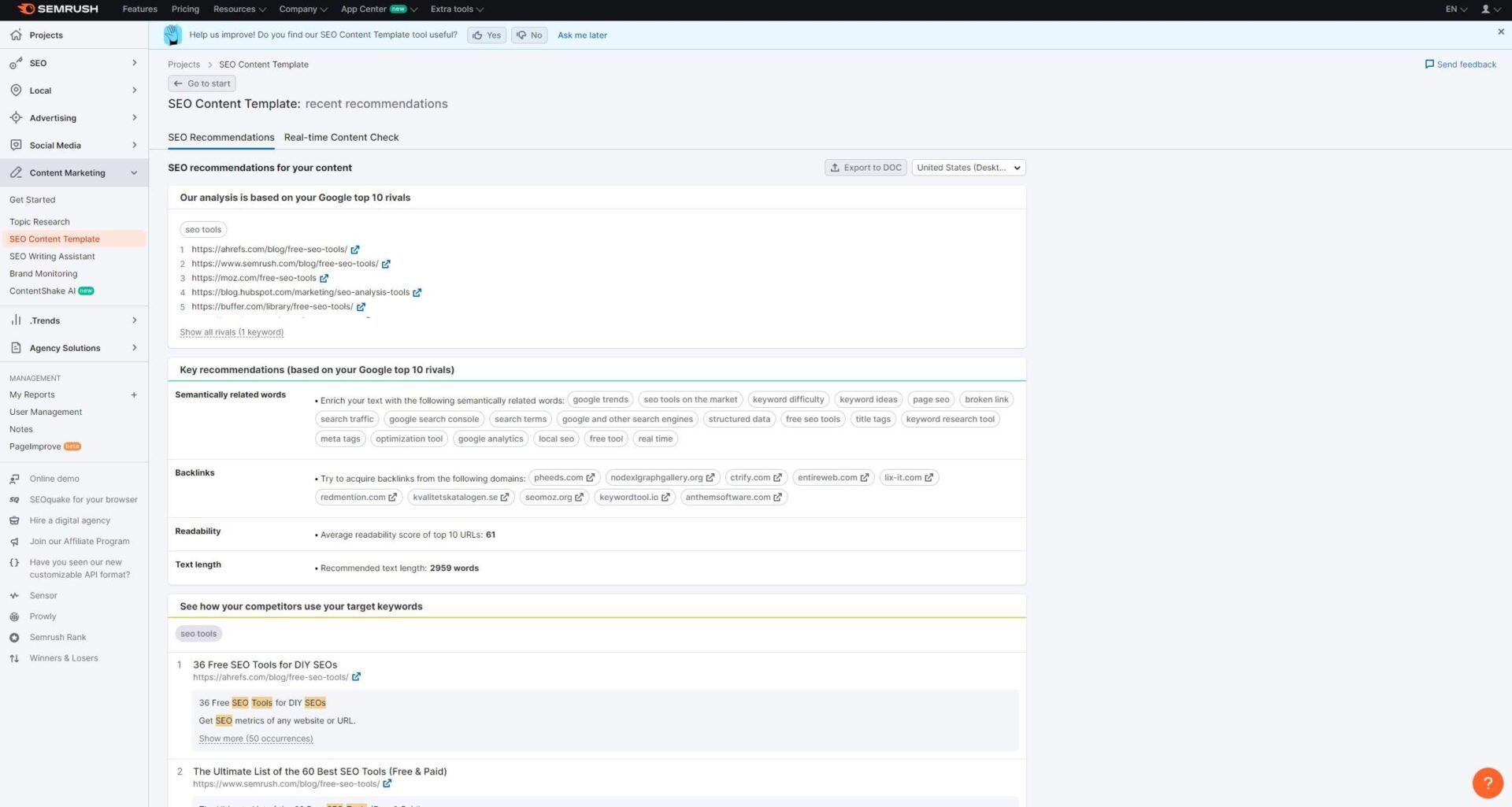
Last but not least, the SEO Content Template provides an SEO content brief based on the target keyword — you know how important keywords are. Provide the one you want to rank for and get SEO recommendations, LSI keywords, recommended backlinks, text length, etc.
Semrush also contains the ContentShake AI tool, which is premium, but with a free trial. It’s your AI-driven tool for rewriting and injecting new content ideas to diversify and enrich your website.
In our experience with all three, we found Semrush a smidge better than Ahrefs for content marketing. However, Ahrefs’ AI Content Helper is a massive improvement, which has brought Ahrefs much closer to its rival. Moz is out of the game due to the lack of similar features.
The Bottom Line: Semrush is the Best Option in 2025
To conclude this Semrush vs Ahrefs vs Moz rivalry, we think you already know the outcome.
Semrush ended up on the winning podium, as it’s slightly better than Ahrefs in pretty much every aspect. We actually think Ahrefs is on par with Semrush in most instances, but the latter edges it out with more (innovative) features and in-depth information in all of its tools.
Moz is a reliable tool, and we can’t say much negative about it.
Unfortunately, when compared to Semrush and Ahrefs, it seems a bit anemic. This is reflected in its reporting prowess, where Moz doesn’t deliver as much information as the other two powerful rivals. With everything said, Semrush and Ahrefs should be your focal points, with Moz being a cheaper alternative for basic SEO needs.